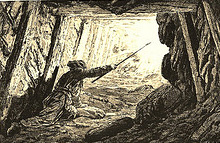Underground Firemen… one of the most dangerous jobs held by mankind:
In early Industrial coal mines gas detection was carried out using the wet sack and candle method: “Covering himself with a sack cloth saturated with water, the fireman advanced towards the place where firedamp (mostly methane) existed, and creeping on his belly, held a long pole before him with one or more lighted candles at its end. This ignited the firedamp and produced an explosion more or less violent according to the quantity of gas accumulated. As the flame ran along the roof, the fireman lay flat on his belly until it passed over him. When the operations of the fireman were completed, the rest of the colliers entered the mine and the motion of air caused by their working prevented the gas from collecting during the day” (A History of Coal Mining in Great Britain, 1882).
In some areas the role of fireman was allocated to convicted criminals. If the fireman survived (unlikely) he would be pardoned.





To Terry Kirkpatrick’s comment, my grandfather was also a miner in Scotland. But it wasn’t until we recently found my mother’s birth certificate where is occupation was listed as “Collier Fireman” . No wonder he ended up with lung issues!
My grandfather was a coal miner in Scotland. When he immigrated to the U.S. in 1925, the occupation listed on the ship’s manifest was “underground fireman”. He joined the Coal Miners Union when he lived in Ohio and Pennsylvania.
My great uncle worked as a mine safety engineer at least that’s what he said. Describing what he did once he said he was the guy who went down the pit first and lit a match to see if it blew up before the miners went down. He was old at the time and I’m sure they had more sophisticated equipment to detect gas but still probably was dangerous. My grandad advised me not to make any negative comments about the miners union when in his company either.